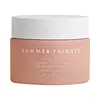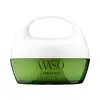What's inside
What's inside
 Key Ingredients
Key Ingredients

 Benefits
Benefits

 Concerns
Concerns

 Ingredients Side-by-side
Ingredients Side-by-side

Water
Skin ConditioningPropanediol
SolventDicaprylyl Carbonate
EmollientGlycerin
HumectantPentylene Glycol
Skin ConditioningSodium Hyaluronate
HumectantHydrolyzed Sodium Hyaluronate
Skin ConditioningGlycine
BufferingSerine
MaskingGlutamic Acid
HumectantAspartic Acid
MaskingLeucine
Skin ConditioningAlanine
MaskingLysine
Skin ConditioningArginine
MaskingTyrosine
MaskingPhenylalanine
MaskingProline
Skin ConditioningThreonine
Valine
MaskingIsoleucine
Skin ConditioningHistidine
HumectantAscorbic Acid
AntioxidantSaccharide Isomerate
HumectantHaematococcus Pluvialis Extract
AntioxidantCeramide NP
Skin ConditioningTocopheryl Acetate
AntioxidantTocopherol
AntioxidantHexapeptide-11
Skin ConditioningPalmitoyl Tripeptide-1
Skin ConditioningAnanas Sativus Fruit Extract
Skin ConditioningSaccharomyces/Magnesium Ferment
Saccharomyces/Copper Ferment
Skin ConditioningSaccharomyces/Silicon Ferment
Skin ConditioningButylene Glycol
HumectantGlyceryl Acrylate/Acrylic Acid Copolymer
HumectantGlyceryl Caprylate
EmollientSucrose Stearate
EmollientLecithin
EmollientPolyglyceryl-10 Laurate
Skin ConditioningXanthan Gum
EmulsifyingCetearyl Olivate
Sorbitan Olivate
EmulsifyingSodium Citrate
BufferingCarbomer
Emulsion StabilisingCitric Acid
BufferingCetearyl Alcohol
EmollientSodium Hydroxide
BufferingLactobacillus Ferment
Skin ConditioningLeuconostoc/Radish Root Ferment Filtrate
AntimicrobialHydroxyacetophenone
AntioxidantCI 77491
Cosmetic ColorantWater, Propanediol, Dicaprylyl Carbonate, Glycerin, Pentylene Glycol, Sodium Hyaluronate, Hydrolyzed Sodium Hyaluronate, Glycine, Serine, Glutamic Acid, Aspartic Acid, Leucine, Alanine, Lysine, Arginine, Tyrosine, Phenylalanine, Proline, Threonine, Valine, Isoleucine, Histidine, Ascorbic Acid, Saccharide Isomerate, Haematococcus Pluvialis Extract, Ceramide NP, Tocopheryl Acetate, Tocopherol, Hexapeptide-11, Palmitoyl Tripeptide-1, Ananas Sativus Fruit Extract, Saccharomyces/Magnesium Ferment, Saccharomyces/Copper Ferment, Saccharomyces/Silicon Ferment, Butylene Glycol, Glyceryl Acrylate/Acrylic Acid Copolymer, Glyceryl Caprylate, Sucrose Stearate, Lecithin, Polyglyceryl-10 Laurate, Xanthan Gum, Cetearyl Olivate, Sorbitan Olivate, Sodium Citrate, Carbomer, Citric Acid, Cetearyl Alcohol, Sodium Hydroxide, Lactobacillus Ferment, Leuconostoc/Radish Root Ferment Filtrate, Hydroxyacetophenone, CI 77491
Water
Skin ConditioningDipropylene Glycol
HumectantGlycerin
HumectantAlcohol
AntimicrobialPentaerythrityl Tetraethylhexanoate
EmollientMaltitol
HumectantDimethicone
EmollientTrehalose
HumectantEuphorbia Cerifera Wax
Phenoxyethanol
PreservativePEG-240/Hdi Copolymer Bis-Decyltetradeceth-20 Ether
StabilisingCarbomer
Emulsion StabilisingParfum
MaskingPotassium Hydroxide
BufferingSaccharide Isomerate
HumectantTalc
AbrasiveDipotassium Glycyrrhizate
HumectantDextrin Palmitate
EmulsifyingSodium Metaphosphate
BufferingButylene Glycol
HumectantDisodium EDTA
Acrylates/C10-30 Alkyl Acrylate Crosspolymer
Emulsion StabilisingCarthamus Tinctorius Seed Oil
MaskingSerine
MaskingButylphenyl Methylpropional
PerfumingLimonene
PerfumingHexyl Cinnamal
PerfumingLinalool
PerfumingBenzyl Benzoate
AntimicrobialCalcium Stearate
Cosmetic ColorantCI 77492
Cosmetic ColorantCitric Acid
BufferingSodium Citrate
BufferingCitronellol
PerfumingPaeonia Suffruticosa Root Extract
Skin ProtectingGeraniol
PerfumingDaucus Carota Sativa Root Protoplasts
EmollientCitrus Junos Seed Extract
AntioxidantPEG-30 Phytosterol
EmulsifyingHydrogenated Lecithin
EmulsifyingTriisostearin
Skin ConditioningPanax Ginseng Root Extract
EmollientBHT
AntioxidantTrimethylolpropane Triethylhexanoate
EmollientPlankton Extract
Skin ConditioningSodium Phosphate
BufferingTrisodium EDTA
Polysilicone-2
Tocopherol
AntioxidantWater, Dipropylene Glycol, Glycerin, Alcohol, Pentaerythrityl Tetraethylhexanoate, Maltitol, Dimethicone, Trehalose, Euphorbia Cerifera Wax, Phenoxyethanol, PEG-240/Hdi Copolymer Bis-Decyltetradeceth-20 Ether, Carbomer, Parfum, Potassium Hydroxide, Saccharide Isomerate, Talc, Dipotassium Glycyrrhizate, Dextrin Palmitate, Sodium Metaphosphate, Butylene Glycol, Disodium EDTA, Acrylates/C10-30 Alkyl Acrylate Crosspolymer, Carthamus Tinctorius Seed Oil, Serine, Butylphenyl Methylpropional, Limonene, Hexyl Cinnamal, Linalool, Benzyl Benzoate, Calcium Stearate, CI 77492, Citric Acid, Sodium Citrate, Citronellol, Paeonia Suffruticosa Root Extract, Geraniol, Daucus Carota Sativa Root Protoplasts, Citrus Junos Seed Extract, PEG-30 Phytosterol, Hydrogenated Lecithin, Triisostearin, Panax Ginseng Root Extract, BHT, Trimethylolpropane Triethylhexanoate, Plankton Extract, Sodium Phosphate, Trisodium EDTA, Polysilicone-2, Tocopherol
 Reviews
Reviews

Ingredients Explained
These ingredients are found in both products.
Ingredients higher up in an ingredient list are typically present in a larger amount.
Butylene Glycol (or BG) is used within cosmetic products for a few different reasons:
Overall, Butylene Glycol is a safe and well-rounded ingredient that works well with other ingredients.
Though this ingredient works well with most skin types, some people with sensitive skin may experience a reaction such as allergic rashes, closed comedones, or itchiness.
Learn more about Butylene GlycolCarbomer is a polymer of acrylic acid. Its main role is to create a gel consistency.
A high amount of carbomer can cause pilling or balling up of products. Don't worry, most products contain 1% or less of carbomer.
Citric Acid is an alpha hydroxy acid (AHA) naturally found in citrus fruits like oranges, lemons, and limes.
Like other AHAs, citric acid can exfoliate skin by breaking down the bonds that hold dead skin cells together. This helps reveal smoother and brighter skin underneath.
However, this exfoliating effect only happens at high concentrations (20%) which can be hard to find in cosmetic products.
Due to this, citric acid is usually included in small amounts as a pH adjuster. This helps keep products slightly more acidic and compatible with skin's natural pH.
In skincare formulas, citric acid can:
While it can provide some skin benefits, research shows lactic acid and glycolic acid are generally more effective and less irritating exfoliants.
Most citric acid used in skincare today is made by fermenting sugars (usually from molasses). This synthetic version is identical to the natural citrus form but easier to stabilize and use in formulations.
Read more about some other popular AHA's here:
Learn more about Citric AcidGlycerin is already naturally found in your skin. It helps moisturize and protect your skin.
A study from 2016 found glycerin to be more effective as a humectant than AHAs and hyaluronic acid.
As a humectant, it helps the skin stay hydrated by pulling moisture to your skin. The low molecular weight of glycerin allows it to pull moisture into the deeper layers of your skin.
Hydrated skin improves your skin barrier; Your skin barrier helps protect against irritants and bacteria.
Glycerin has also been found to have antimicrobial and antiviral properties. Due to these properties, glycerin is often used in wound and burn treatments.
In cosmetics, glycerin is usually derived from plants such as soybean or palm. However, it can also be sourced from animals, such as tallow or animal fat.
This ingredient is organic, colorless, odorless, and non-toxic.
Glycerin is the name for this ingredient in American English. British English uses Glycerol/Glycerine.
Learn more about GlycerinSaccharide Isomerate comes from sugars found in corn. It is a skin hydrator.
The structure of this ingredient can be altered to be more similar to the carbohydrates found in our skin. This ability to mimic our skin gives it hydrating properties.
Specifically, saccharide Isomerate is a humectant. Humectants draw moisture from the air to our skin.
Research shows Saccharide Isomerate to be an effective moisturizer.
Learn more about Saccharide IsomerateSerine is an amino acid naturally found in our body. Our bodies use amino acids to create protein.
Amino-acids help give keep our skin hydrated. They play an important role in the skin barrier, which keeps the skin plump and firm.
Serine is a non-essential amino acid, meaning we don't need to obtain it from eating foods.
Learn more about SerineSodium Citrate is the sodium salts of citric acid. In skincare, it is used to alter pH levels and acts as a preservative.
Its main functions are to maintain the pH of a product and neutralize metal ions.
The acidity of our skin is maintained by our glands and skin biome; normal pH level of skin is slightly acidic (~4.75-5.5).
Being slightly acidic allows our skin to create an "acid mantle". This acid mantle is a thin barrier that protects our skin from bacteria and contaminants.
Learn more about Sodium CitrateTocopherol (also known as Vitamin E) is a common antioxidant used to help protect the skin from free-radicals and strengthen the skin barrier. It's also fat soluble - this means our skin is great at absorbing it.
Vitamin E also helps keep your natural skin lipids healthy. Your lipid skin barrier naturally consists of lipids, ceramides, and fatty acids. Vitamin E offers extra protection for your skin’s lipid barrier, keeping your skin healthy and nourished.
Another benefit is a bit of UV protection. Vitamin E helps reduce the damage caused by UVB rays. (It should not replace your sunscreen). Combining it with Vitamin C can decrease sunburned cells and hyperpigmentation after UV exposure.
You might have noticed Vitamin E + C often paired together. This is because it is great at stabilizing Vitamin C. Using the two together helps increase the effectiveness of both ingredients.
There are often claims that Vitamin E can reduce/prevent scarring, but these claims haven't been confirmed by scientific research.
Learn more about TocopherolWater. It's the most common cosmetic ingredient of all. You'll usually see it at the top of ingredient lists, meaning that it makes up the largest part of the product.
So why is it so popular? Water most often acts as a solvent - this means that it helps dissolve other ingredients into the formulation.
You'll also recognize water as that liquid we all need to stay alive. If you see this, drink a glass of water. Stay hydrated!
Learn more about Water